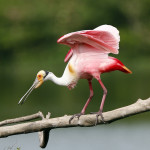• • •
Roseate Spoonbills are almost a cartoon bird, with a ridiculous spatula for a bill, a bald head, bright pink and scarlet plumage and an awkward takeoff that appears to require tremendous effort. Casual observers look at them and see Flamingos.
• Length: 32 inches
• Wingspan: 50 inches
• Season: Summer/Year-round
More about Roseate Spoonbills.
Where they are, and when.
Juveniles start out a pale pink and white with a gray bill and gradually darken by their third year to a deep pink with scarlet highlights and an orange tail.
To forage, they wade in groups in in shallow water, sweeping their unusual bills back and forth to grab small fish, crustaceans, mollusks and insects.
They nest in large rookeries on islands with Cormorants, Great and Snowy Egrets and other herons from March to June. Their courtship involves rubbing their bills together and presenting sticks to each other that they hold together in their bills.
Their nests are platforms of sticks and twigs in low trees or shrubs. They nurture two to five white eggs with dark spots. Once paired, they are monogamous and share parenting duties, including feeding their young, which leave the nest after about two months. During breeding season, they are in continuous motion, shuttling from their nests to feeding grounds and back.
Although most Roseate Spoonbills migrate to Central and South America in winter, there is a small year-round population on the Texas coast.
April 21, 2008
This was my first visit to the Rookery, and it was overwhelming in a lot of ways, but the most captivating spectacle was the frenzy and chatter of the Roseate Spoonbills. They shuttled back and forth incessantly between the small, crowded island of nests and the far end of the lake. Almost on a schedule, one would fly up and head in one direction while another came soaring back in the other, often with a stick in its bill. On the island, the activity was nonstop. Birds courting. Birds fighting. Chasing each other off a perch. And all of it amid a constant chatter, like a thousand conversations going on at once.







You must be logged in to post a comment.